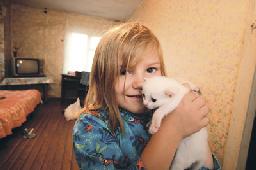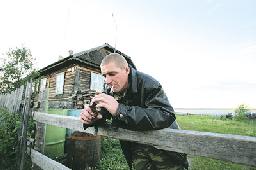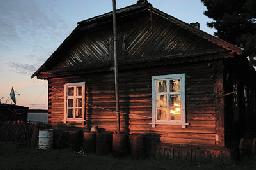









 While studying Stalin’s railroad - more precisely, by researching into what
had remained of it, we drew a number of consequences, among them the following:
when they began to execute the order and tackle its construction, nobody gave
any thought to the question what all this might be in aid for. Why should they
lay rails and sleepers in the remote taiga, abundantly covered with vegetation,
on swampy ground and in icy frost, the more since this project meant a huge
expenditure of human labour and construction materials. However, those times
would not allow any careful consideratrion to come up.
While studying Stalin’s railroad - more precisely, by researching into what
had remained of it, we drew a number of consequences, among them the following:
when they began to execute the order and tackle its construction, nobody gave
any thought to the question what all this might be in aid for. Why should they
lay rails and sleepers in the remote taiga, abundantly covered with vegetation,
on swampy ground and in icy frost, the more since this project meant a huge
expenditure of human labour and construction materials. However, those times
would not allow any careful consideratrion to come up.
But he, the man who evidently equated the scale of plans he had signed with the prominent role he was playing, was he able to give a reply to this question? Or was it just some abnormal wishful thinking about making use of the huge army of GULAG prisoners, which was hidden behind all those “loud and sparkling words”? Even now, more than half a century later, they have not been able to find an exact reply or explanation..
The participants of our expedition which ended in Turukhansk, changed to another barge with less people aboard, after they had taken a short rest. They intended to continue their trip upwards the Yenisey up to Kureyka most probably for two main reasons: first of all they were in search of the truth, secondly they had the illusory wish to experience the roughness of the 1950s to an even greater extent.
 Why is this settlement so famed? First of all, because the tsarist government
used to exile members of the RSDLP (Russian Social Democratic Labour Party;
translator’s note) to this place, revolutionaries such as Josef Dzugashvili. The
little wooden house of the Taraseevs, where Stalin lived during his exile, was
later removed and rebuilt inside the pavillion of the J. Stalin Museum, which
was constructed in Kureyka from funds of the Norilsk Iron and Steel Combine; and
for Anfisa Stepanovna Taraseeva they built an entirely new, solid house.
Why is this settlement so famed? First of all, because the tsarist government
used to exile members of the RSDLP (Russian Social Democratic Labour Party;
translator’s note) to this place, revolutionaries such as Josef Dzugashvili. The
little wooden house of the Taraseevs, where Stalin lived during his exile, was
later removed and rebuilt inside the pavillion of the J. Stalin Museum, which
was constructed in Kureyka from funds of the Norilsk Iron and Steel Combine; and
for Anfisa Stepanovna Taraseeva they built an entirely new, solid house.
Towards the summer of the year 1950 they sent prisoner brigades from Norilsk. They were made up by experienced construction workers who had all received a low degree of penalty – about 200 individuals in all. It was assumed that the larchwood poles, which they drove into the ground just below the ferroconcrete fundament of the future pavillion, would be subject to a time of permanency of two-hundred years. And the window panes were engineered in a way that they would not freeze up even in periods of icy frost.
In front of the pavillion, standing on a high pedastal – the statue of the leader, ten meters in height, made of ferroconcrete (all coated by gypsum). This genial construction project was completed in the summer of 1952, and just on the adjacent territory they started a new one, which was also intrinsically tied to the name of the leader.
 In the autumn of 1953 little camp towns sprang up like mushrooms in the places
were the “death road” was to be constructed - the were to turn out into a huge
railroad cemetery. Nobody ever counted the number of dead bodies who lost their
lives during the construction of the railroad. Not even grave-mounds remained
there.
In the autumn of 1953 little camp towns sprang up like mushrooms in the places
were the “death road” was to be constructed - the were to turn out into a huge
railroad cemetery. Nobody ever counted the number of dead bodies who lost their
lives during the construction of the railroad. Not even grave-mounds remained
there.
The route extending across the polar region, the rails of which seemed to lead to nowhere, could either become a memorial in memory of the victims of the GULAG, or all those people, who gost lost in these places for ever. Five years after trains had stopped to use this great Northern Railroad, after the “ferroconcrete” leader had been pulled down from his pedestal by means of a tractor and drowned in the waters of the Yenisey, the museum was closed and the whole territory began to quickly get overgrown and deserted. And just the same happened to the road bed, which had been laid right through the swamps with so much trouble.
We, chief editor Vladimir Pavlovskiy, photo correspondent Aleksander Kuznetsov, as well as the author of these lines, had to force our way through a gigantic thicket of stinging nettles, a dense network of twigs, roots and all kinds of brushwood, which left painful marks in our faces, while, at the same time, our legs were sinking into a disgustingly filthy, stinking broth. But then, finally, we reached the site of the destroyed structure.
We were walking in silence one after the other, each of us being lost in thought.
 For some reason or other I recalled the pantheon project of architect V. Pestov,
which he had proposed towards the end of the war. On the photo you could see a
quay wall covered by granite, and two little spruces growing in the very
distance.
For some reason or other I recalled the pantheon project of architect V. Pestov,
which he had proposed towards the end of the war. On the photo you could see a
quay wall covered by granite, and two little spruces growing in the very
distance.
And HE was looking down from his pedestal, probably having great visions about
the future of his country, which was intrinsically tied to his own.
Pictures from the year 1953 , when the pantheon was opened, gave a much more moderate impression. And our creative group, in fact, found nothing but a sole ruin. Just a few pieces from the walls had been left from what had once been a wooden hut. Anyway, I did not intend to risk my life by trying to continue my way through this wilderness.
I was just shuddering to think that I might either get lost, or that the mosquitos, which seemed to be particularly malignant in this “holy” place, would eat me completely up. And why, the hell, did we refuse the offer of this boy from Kureyka, who had suggested to drive us around by tractor?
Our cutter moored at the landing stage in Kureyka a long time after midnight, but the road looked as if brightly lit up. The sky, however, was all covered with black clouds. It reminded me of photos from the long ago 1950s, of pictures taken by Ryausov. Maybe this was the stamp of the past?
The settlement which had once occupied both riverbanks is now concentrated on one riverside only. All that remained to the inhabitants on the opposite side today is the cemetery, where there relatives are buried. There we can find the grave of Mikhail Bakaldin’s great-grandmother. And Mikhail’s grandfather held the position of the head of the women’s camp not far from Stalin’s railroad.
 The lad feesl terribly bored. Young people come to visit here only in the summer
if at all. There are no jobs, people here live on barter economy. There are a
some very successful farmers, such as Zinaida Nikolaevna Nagornaya. Her
vegetable patches laid out under permafrost conditions beyond the polar circle,
might even cause the most passionate horticulturist to go green with envy. But
where are the vegetables to be marketed? Where can they be converted into cash?
Maybe, they could offer them for sale to passengers when those debark from one
of the steamers passing by, but what is the use anyhow? The number of passengers
getting astray in this district is evanescent.
The lad feesl terribly bored. Young people come to visit here only in the summer
if at all. There are no jobs, people here live on barter economy. There are a
some very successful farmers, such as Zinaida Nikolaevna Nagornaya. Her
vegetable patches laid out under permafrost conditions beyond the polar circle,
might even cause the most passionate horticulturist to go green with envy. But
where are the vegetables to be marketed? Where can they be converted into cash?
Maybe, they could offer them for sale to passengers when those debark from one
of the steamers passing by, but what is the use anyhow? The number of passengers
getting astray in this district is evanescent.
Kureyka, the little place of Kureyka, became a legend, a small page within the book of history of the state. If the pantheon project had been realized, they would have laid public gardens and parks, places and boulevards in the course of time. The project makers originally planned steamships to moor, trains to stop over and “iron” birds to land in this place at regular intervals. And happy children would be all smiles!
These dreams have not yet vanished – they are still alive, just as they were before. People are discussing in public and in great seriosity about the reconstruction of the transpolar railroad, so that, possibly, the expedition carried out out by staff members of the “Krasnoyarsk Labourer” along Stalin’s railroad, in Kureyka, has not yet come to an end. Maybe, it will be continued in the next summer.
Tatyana MAKOGONOVA.
ON THE PHOTOS: This is who Stalin’S Pantheon presented itself to tourists at
that time.
The girl would still like to spend the summer vacation at her grandparents’
house in Kureyka.
Mikhail Bakaldin feels bored in this half-deserted settlement. And this is all
that remained after the Pantheon had burned down.
Photos: by Aleksander KUZNETSOV.
“Krasnoyarsk Labourer”, 24.09.2005